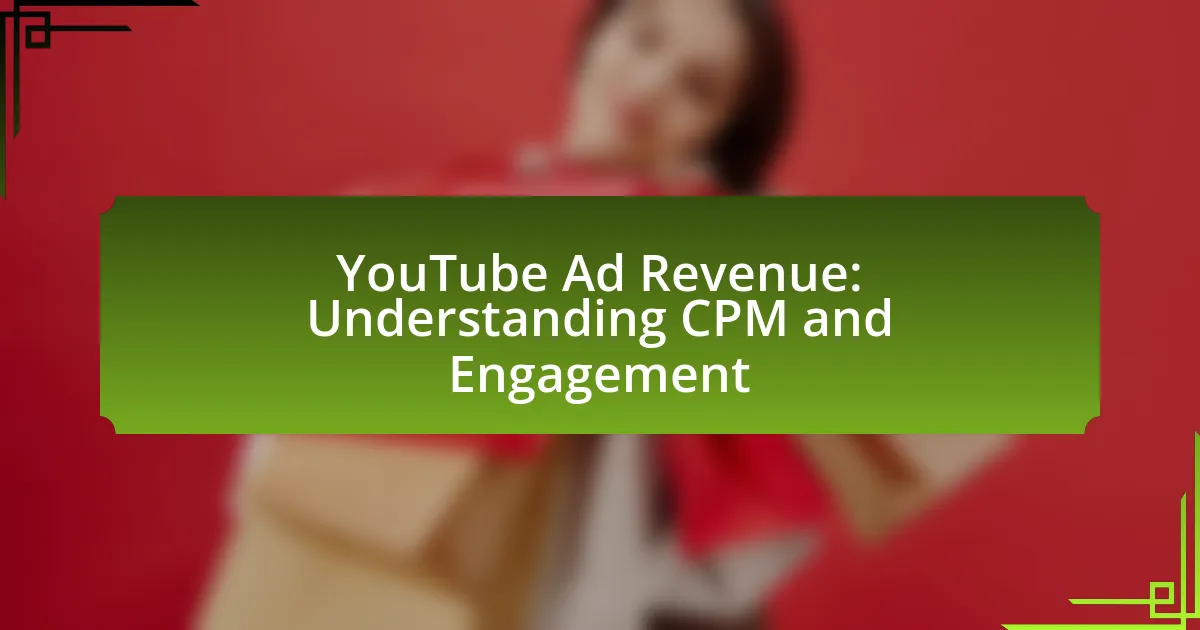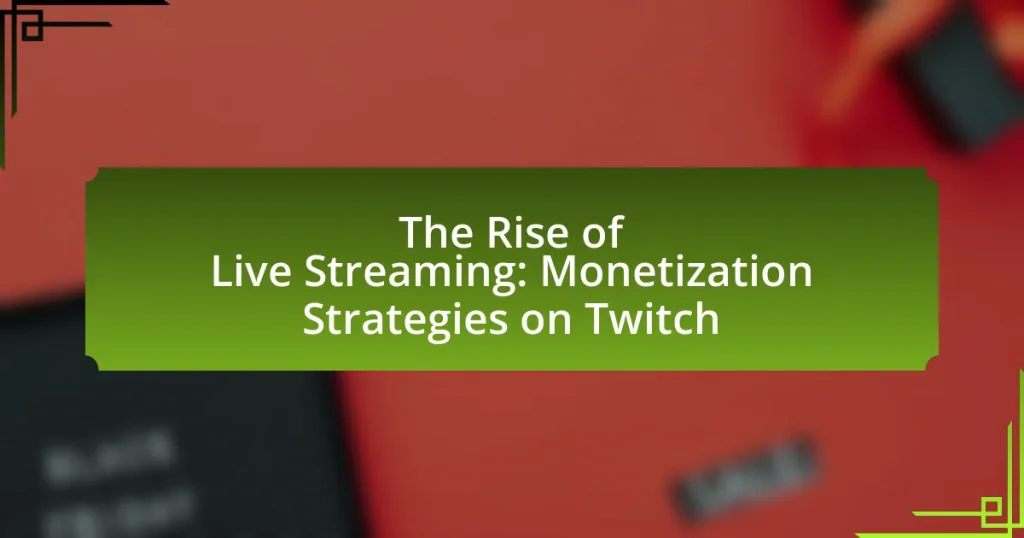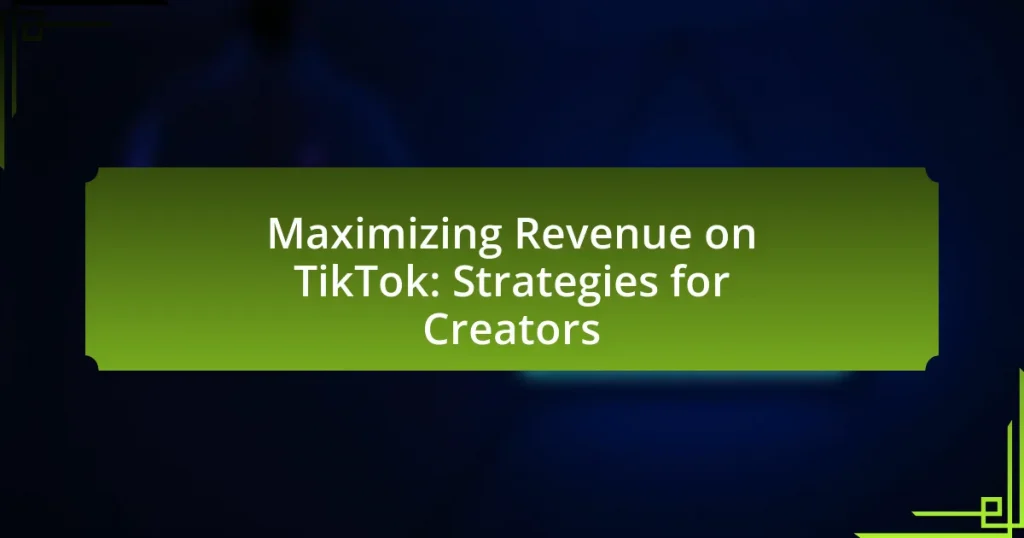YouTube Ad Revenue refers to the income generated by the platform through advertisements displayed on videos, which amounted to approximately $29.2 billion in 2022. This revenue is primarily derived from various ad formats, including display ads and video ads, and is shared between YouTube and content creators who participate in the YouTube Partner Program. Understanding key metrics such as Cost Per Mille (CPM) and audience engagement is crucial for creators, as these factors directly influence their revenue potential. The article explores how ad placement, viewer retention, and engagement strategies impact CPM rates and overall ad revenue, while also providing best practices for maximizing earnings on the platform.
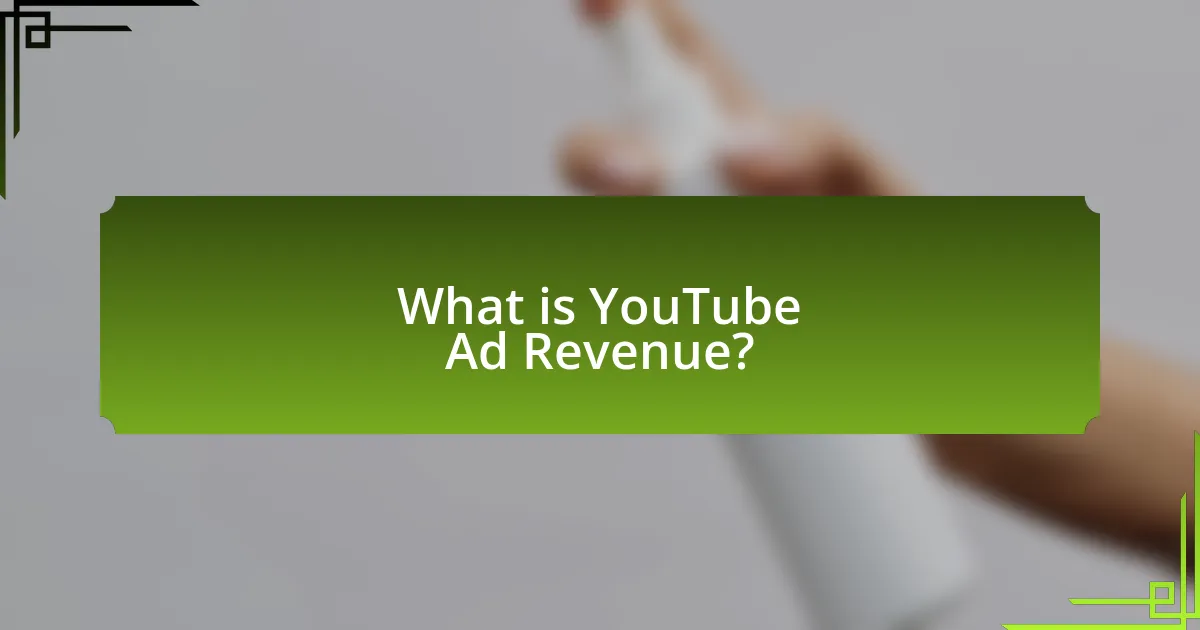
What is YouTube Ad Revenue?
YouTube Ad Revenue is the income generated by YouTube through advertisements displayed on videos. This revenue primarily comes from two types of ads: display ads, which appear beside videos, and video ads, which play before, during, or after content. In 2022, YouTube generated approximately $29.2 billion in ad revenue, showcasing its significant role in digital advertising. The revenue is shared between YouTube and content creators, incentivizing creators to produce engaging content that attracts viewers and advertisers.
How is YouTube Ad Revenue generated?
YouTube ad revenue is generated primarily through advertisements displayed on videos, which are monetized by content creators who are part of the YouTube Partner Program. Advertisers pay YouTube to display their ads, and revenue is shared between YouTube and the content creators based on metrics such as Cost Per Mille (CPM), which refers to the cost per thousand impressions. In 2022, YouTube generated approximately $29.2 billion in ad revenue, demonstrating the platform’s significant role in digital advertising. This revenue model incentivizes creators to produce engaging content that attracts viewers, thereby increasing ad impressions and overall earnings.
What types of ads contribute to YouTube Ad Revenue?
YouTube Ad Revenue is primarily generated through several types of ads, including display ads, overlay ads, skippable video ads, non-skippable video ads, and bumper ads. Display ads appear beside the video, overlay ads are semi-transparent ads that appear on the lower portion of the video, skippable video ads allow viewers to skip after five seconds, non-skippable video ads must be watched in full before the video, and bumper ads are short, non-skippable ads of six seconds. According to YouTube’s advertising guidelines, these ad formats collectively contribute to the platform’s revenue by providing advertisers with various options to reach their target audiences effectively.
How does ad placement affect revenue generation?
Ad placement significantly impacts revenue generation by influencing viewer engagement and click-through rates. Strategic ad placement, such as positioning ads at the beginning or during high-engagement moments of a video, can lead to higher visibility and interaction, thereby increasing the likelihood of revenue through cost-per-thousand impressions (CPM) and cost-per-click (CPC) models. For instance, research indicates that ads placed within the first 30 seconds of a video can achieve up to 50% higher engagement rates compared to those placed at the end, directly correlating to increased revenue.
Why is understanding CPM important for YouTube creators?
Understanding CPM (Cost Per Mille) is crucial for YouTube creators because it directly impacts their revenue potential from advertisements. CPM represents the amount advertisers are willing to pay for every 1,000 ad impressions, and a higher CPM indicates greater earnings for creators. For instance, according to YouTube’s monetization policies, creators can earn between $0.25 to $4.00 per 1,000 views, depending on factors like audience demographics and content type. By analyzing CPM, creators can optimize their content strategy, target specific audiences, and ultimately increase their ad revenue.
What does CPM stand for and how is it calculated?
CPM stands for Cost Per Mille, which refers to the cost of 1,000 impressions of an advertisement. It is calculated by dividing the total cost of the advertising campaign by the number of impressions (in thousands) that the ad receives. For example, if an advertiser spends $500 for 200,000 impressions, the CPM would be calculated as ($500 / 200) = $2.50. This metric is commonly used in digital advertising to assess the cost-effectiveness of ad placements.
How does CPM vary across different content types?
CPM, or Cost Per Mille, varies significantly across different content types on YouTube. For instance, educational content typically commands a higher CPM, often exceeding $20, due to its targeted audience and advertiser demand. In contrast, entertainment content generally sees lower CPM rates, averaging around $5 to $10, as it attracts a broader but less niche audience. This variation is influenced by factors such as audience demographics, engagement levels, and the specific interests of advertisers, with niche markets often yielding higher CPMs due to less competition and more targeted advertising opportunities.
What role does audience engagement play in YouTube Ad Revenue?
Audience engagement significantly influences YouTube ad revenue by directly affecting the platform’s monetization metrics. Higher engagement rates, such as likes, comments, and shares, lead to increased viewer retention and longer watch times, which are critical factors in YouTube’s algorithm for promoting content. According to YouTube’s own guidelines, videos with higher engagement are more likely to be recommended, resulting in more ad impressions and, consequently, higher revenue for creators. Additionally, a study by Tubefilter found that channels with strong audience interaction can earn up to 50% more in ad revenue compared to those with lower engagement levels. Thus, audience engagement is a key driver of YouTube ad revenue, enhancing visibility and monetization opportunities for creators.
How is engagement measured on YouTube?
Engagement on YouTube is measured through metrics such as watch time, likes, comments, shares, and subscriber growth. These metrics indicate how viewers interact with content, reflecting their interest and investment in the videos. For instance, watch time is a critical metric, as it shows the total minutes viewers spend watching a video, which directly influences a video’s ranking in search results and recommendations. Additionally, likes and comments provide direct feedback from viewers, while shares indicate how often content is distributed across other platforms. Subscriber growth is another key indicator, as it reflects the channel’s ability to retain viewers and convert them into loyal followers. Collectively, these metrics help creators and advertisers assess the effectiveness of their content and strategies on the platform.
What impact does viewer retention have on revenue?
Viewer retention significantly impacts revenue by directly influencing advertising effectiveness and overall monetization potential. Higher viewer retention rates lead to longer watch times, which in turn increase the likelihood of ad impressions and engagement with those ads. For instance, YouTube’s algorithm favors videos with high retention, promoting them more prominently, which can result in increased views and higher CPM (cost per thousand impressions) rates. According to a study by Tubefilter, videos with a retention rate above 50% can earn up to 2.5 times more revenue than those with lower retention, demonstrating a clear correlation between viewer retention and revenue generation.

How do CPM and Engagement Interact?
CPM (Cost Per Mille) and engagement interact by influencing the overall effectiveness and profitability of advertising campaigns on platforms like YouTube. Higher engagement rates, such as likes, comments, and shares, can lead to increased visibility and reach, which in turn can elevate CPM rates as advertisers are willing to pay more for ads that reach a more engaged audience. For instance, a study by Google indicated that videos with higher engagement metrics often result in better ad performance, leading to a higher CPM due to the perceived value of reaching an audience that is more likely to interact with the content. Thus, the interaction between CPM and engagement is crucial for maximizing ad revenue on YouTube.
What is the relationship between CPM and viewer engagement?
The relationship between CPM (Cost Per Mille) and viewer engagement is that higher viewer engagement typically leads to increased CPM rates. Advertisers are willing to pay more for ad placements on videos that have higher engagement metrics, such as likes, comments, and shares, because these metrics indicate a more attentive and responsive audience. For instance, a study by Tubular Labs found that videos with higher engagement rates can command CPMs that are 50% to 100% higher than those with lower engagement, demonstrating a direct correlation between viewer interaction and advertising value.
How does higher engagement influence CPM rates?
Higher engagement positively influences CPM (Cost Per Mille) rates by increasing the perceived value of ad placements. Advertisers are willing to pay more for ads that reach a highly engaged audience, as this often leads to better conversion rates and brand awareness. For instance, a study by Google indicated that ads shown on videos with higher viewer engagement can command CPM rates that are 50% higher than those on less engaging content. This correlation exists because higher engagement typically results in longer watch times and more interactions, making the ad space more attractive to advertisers seeking effective reach.
What strategies can creators use to boost engagement and CPM?
Creators can boost engagement and CPM by optimizing video content for audience retention and interaction. Engaging thumbnails and titles increase click-through rates, while maintaining viewer interest through storytelling and high-quality production enhances watch time, a key factor in YouTube’s algorithm. Additionally, creators should encourage viewer interaction through calls to action, such as asking viewers to like, comment, and subscribe, which can lead to higher engagement metrics.
Moreover, leveraging analytics tools to understand audience demographics and preferences allows creators to tailor content that resonates with their viewers, further increasing engagement. According to YouTube’s Creator Academy, videos that maintain a high average view duration tend to rank better, leading to increased ad revenue opportunities. By implementing these strategies, creators can effectively enhance both engagement and CPM.
Why should creators focus on both CPM and engagement?
Creators should focus on both CPM (Cost Per Mille) and engagement because these metrics directly influence their revenue and audience retention. CPM indicates the earnings per thousand ad impressions, while engagement reflects how actively viewers interact with content. High engagement can lead to increased viewership and, consequently, higher CPM rates, as advertisers prefer content that captivates audiences. For instance, a study by Tubular Labs found that videos with higher engagement rates can command CPMs up to 50% higher than those with lower engagement. Therefore, balancing both metrics is essential for maximizing revenue and fostering a loyal viewer base.
How can balancing CPM and engagement lead to sustainable revenue?
Balancing Cost Per Mille (CPM) and engagement can lead to sustainable revenue by optimizing ad placements that maximize both advertiser satisfaction and viewer retention. When CPM is high, it indicates that advertisers are willing to pay more for ad impressions, which can increase revenue; however, if engagement drops due to excessive or poorly targeted ads, viewers may abandon the content. Research shows that platforms achieving a balance between high CPM and strong viewer engagement, such as YouTube, can maintain viewer loyalty while attracting premium advertisers, ultimately leading to consistent revenue streams. For instance, a study by eMarketer found that video ads with higher engagement rates can command up to 50% more in CPM, demonstrating the financial benefits of this balance.
What are the risks of prioritizing one over the other?
Prioritizing CPM (Cost Per Mille) over engagement can lead to reduced viewer satisfaction and loyalty. When content creators focus solely on maximizing ad revenue through high CPM rates, they may produce less engaging content that fails to resonate with their audience. This can result in decreased viewer retention and lower overall engagement metrics, which are critical for long-term success on platforms like YouTube. According to a study by Tubular Labs, channels that prioritize viewer engagement tend to see a 50% higher retention rate compared to those that focus primarily on ad revenue. Thus, neglecting engagement in favor of CPM can ultimately harm a channel’s growth and sustainability.
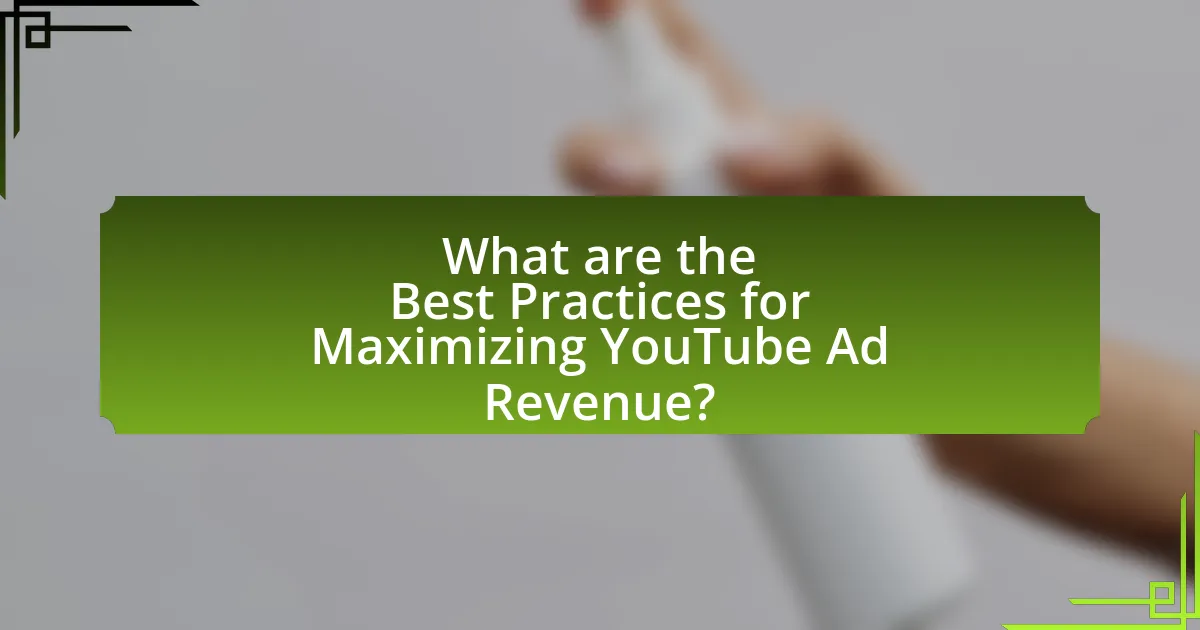
What are the Best Practices for Maximizing YouTube Ad Revenue?
To maximize YouTube ad revenue, creators should focus on optimizing content for viewer engagement and targeting high CPM (cost per thousand impressions) niches. Engaging content retains viewers longer, which increases ad impressions and revenue. For instance, videos that encourage interaction, such as comments and shares, can boost visibility and attract more advertisers. Additionally, targeting niches like finance or technology, which typically have higher CPM rates, can significantly enhance revenue potential. According to YouTube’s Creator Academy, channels that maintain a consistent upload schedule and utilize SEO strategies to improve discoverability can also see increased ad revenue.
How can creators optimize their content for better CPM?
Creators can optimize their content for better CPM by focusing on audience engagement, content quality, and strategic keyword usage. High audience engagement leads to longer watch times, which YouTube’s algorithm favors, resulting in higher ad placements and increased CPM rates. Additionally, producing high-quality content that resonates with viewers encourages shares and subscriptions, further boosting engagement metrics. Using relevant keywords in titles, descriptions, and tags enhances discoverability, attracting a more targeted audience that advertisers prefer, which can also elevate CPM. According to a study by Tubefilter, channels with higher engagement rates can see CPMs increase by up to 50%, demonstrating the direct correlation between these optimization strategies and revenue potential.
What types of content typically yield higher CPM rates?
Content that typically yields higher CPM rates includes finance, technology, and health-related videos. These niches attract advertisers willing to pay more due to their target audience’s purchasing power and engagement levels. For instance, finance content can command CPM rates exceeding $30, as advertisers seek to reach consumers interested in investment and financial products. Similarly, technology reviews and tutorials often see CPM rates around $20, driven by the high interest in tech gadgets and services. Health-related content also garners high CPMs, often ranging from $15 to $25, as brands in the wellness sector aim to connect with health-conscious viewers.
How can creators analyze their CPM performance effectively?
Creators can analyze their CPM performance effectively by utilizing analytics tools provided by platforms like YouTube, which offer detailed insights into ad revenue metrics. These tools allow creators to track CPM trends over time, compare performance across different videos, and assess the impact of audience engagement on revenue. For instance, YouTube Analytics provides data on views, watch time, and estimated earnings, enabling creators to identify which content generates higher CPMs and understand factors influencing these rates, such as viewer demographics and engagement levels.
What engagement strategies can enhance ad revenue?
Engagement strategies that can enhance ad revenue include optimizing video content for viewer retention, utilizing interactive elements like polls and quizzes, and fostering community through comments and live chats. These strategies increase viewer interaction, leading to longer watch times and higher CPM rates. For instance, YouTube reports that videos with higher engagement metrics, such as likes, shares, and comments, tend to rank better in search results and recommendations, ultimately driving more ad impressions and revenue.
How can creators encourage viewer interaction and feedback?
Creators can encourage viewer interaction and feedback by actively engaging their audience through calls to action, such as asking viewers to comment, like, or share their videos. This approach is effective because studies show that videos with explicit prompts for interaction can increase engagement rates significantly, with some creators reporting up to a 30% increase in comments and likes when they include direct requests in their content. Additionally, responding to viewer comments fosters a sense of community and encourages further interaction, as viewers feel valued and heard.
What role does community building play in increasing engagement?
Community building significantly enhances engagement by fostering a sense of belonging among users. When individuals feel connected to a community, they are more likely to participate actively, share content, and interact with others. Research indicates that platforms with strong community ties see higher user retention rates; for instance, a study by the Pew Research Center found that 69% of users who feel part of a community are more likely to engage with content regularly. This increased engagement directly correlates with higher ad revenue, as more interactions lead to greater visibility and monetization opportunities for creators on platforms like YouTube.
What common mistakes should creators avoid to maintain revenue?
Creators should avoid inconsistent content schedules to maintain revenue. Regular uploads help build audience expectations and engagement, which are crucial for maximizing ad revenue. According to a study by Tubefilter, channels that post consistently see a 30% increase in viewer retention, directly impacting CPM rates. Additionally, neglecting audience feedback can lead to decreased engagement; creators who adapt their content based on viewer preferences often experience higher revenue.
How can creators ensure they comply with YouTube’s ad policies?
Creators can ensure compliance with YouTube’s ad policies by thoroughly reviewing and adhering to the platform’s Community Guidelines and Advertiser Policies. These guidelines outline prohibited content types, such as hate speech, adult content, and misleading information, which can lead to demonetization. Additionally, creators should regularly check for updates to these policies, as YouTube frequently revises them to reflect changing standards and regulations. By maintaining content that aligns with these established rules, creators can safeguard their ad revenue and avoid penalties.
What pitfalls can negatively impact both CPM and engagement?
Low-quality content and poor targeting can negatively impact both CPM and engagement. When content fails to resonate with the audience, it leads to lower viewer retention and interaction, which in turn decreases engagement metrics. According to a study by Tubular Labs, videos with high engagement rates can command CPMs that are 50% higher than those with low engagement. Additionally, ineffective targeting can result in ads being shown to irrelevant audiences, leading to lower click-through rates and higher ad spend without corresponding revenue. This misalignment ultimately reduces CPM as advertisers seek better-performing placements.
What practical tips can help creators improve their YouTube Ad Revenue?
Creators can improve their YouTube Ad Revenue by focusing on increasing viewer engagement and optimizing content for higher CPM (Cost Per Mille). Engaging content retains viewers longer, which boosts ad performance; for instance, videos with higher watch time often attract better-paying ads. Additionally, targeting specific niches can lead to higher CPM rates, as advertisers are willing to pay more for access to targeted audiences. According to YouTube’s Creator Academy, creators who post consistently and utilize SEO strategies in titles and descriptions can significantly enhance visibility, leading to increased ad revenue.
